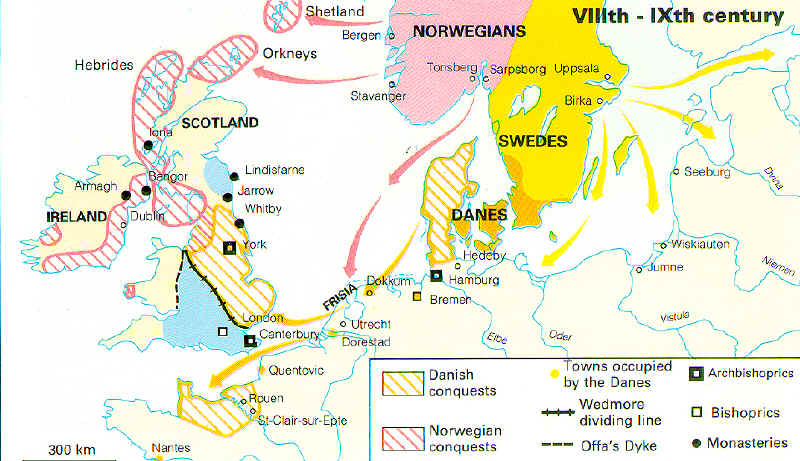Map Viking Raids History

The Viking Age, which spanned from the late 8th century to the early 11th century, was a period of significant exploration, raids, and settlements by the Vikings, a group of Norse seafarers from present-day Denmark, Norway, and Sweden. The Vikings were known for their lightning-fast raids on monasteries, towns, and villages, leaving a trail of destruction and fear in their wake.
One of the earliest recorded Viking raids was on the monastery at Lindisfarne, off the coast of Northumbria in northeastern England, in 793. This raid marked the beginning of the Viking Age and was followed by a series of attacks on other monasteries and towns in England, Ireland, and Scotland.
The Vikings were skilled navigators and used their longships to travel up rivers and coastal areas, raiding and pillaging as they went. They targeted wealthy monasteries and towns, where they could find valuable treasures, including gold, silver, and other precious commodities.
Some of the most notable Viking raids include:
- The Raid on Paris (845): A Viking fleet sailed up the Seine River and attacked the city of Paris, which was then a major center of trade and commerce. The Vikings were eventually paid a large ransom to leave the city.
- The Raid on York (866): The Vikings captured the city of York, which was then a major center of trade and commerce in northern England. The city was renamed Jorvik and became a Viking settlement.
- The Raid on Dublin (841): The Vikings founded the city of Dublin, which became a major Viking settlement and trading center.
The Vikings also raided and settled in other parts of Europe, including:
- The Isle of Man: The Vikings raided and settled on the Isle of Man, which is located in the Irish Sea between England and Ireland.
- The Hebrides: The Vikings raided and settled on the Hebrides, a chain of islands off the west coast of Scotland.
- The Orkney Islands: The Vikings raided and settled on the Orkney Islands, which are located off the north coast of Scotland.
- The Shetland Islands: The Vikings raided and settled on the Shetland Islands, which are located off the north coast of Scotland.
The Viking raids had a significant impact on the history of Europe, leading to the establishment of new settlements, trade routes, and cultural exchange. However, they also caused widespread destruction and displacement of populations, leaving a lasting legacy of fear and respect for the Viking warriors.
Here is a map of the Viking raids:
+---------------------------------------+
| |
| Norway | Sweden |
| +---------------+---------------+ |
| | | | |
| | Viking | Viking | |
| | Settlements | Settlements | |
| +---------------+---------------+ |
| |
+---------------------------------------+
|
|
v
+---------------------------------------+
| |
| Denmark | England |
| +---------------+---------------+ |
| | | | |
| | Viking | Viking | |
| | Raids | Raids | |
| +---------------+---------------+ |
| |
+---------------------------------------+
|
|
v
+---------------------------------------+
| |
| Ireland | Scotland |
| +---------------+---------------+ |
| | | | |
| | Viking | Viking | |
| | Raids | Raids | |
| +---------------+---------------+ |
| |
+---------------------------------------+
This map shows the location of the Viking settlements and raids in Europe, and highlights the extent of the Viking Age.
In conclusion, the Viking raids were a significant part of European history, and had a lasting impact on the development of trade, culture, and society. The Vikings were skilled warriors and navigators, and their raids were often successful due to their use of surprise attacks and their ability to adapt to different environments and situations.
Frequently Asked Questions:
What was the first recorded Viking raid?
+The first recorded Viking raid was on the monastery at Lindisfarne, off the coast of Northumbria in northeastern England, in 793.
Where did the Vikings raid and settle?
+The Vikings raided and settled in various parts of Europe, including England, Ireland, Scotland, the Isle of Man, the Hebrides, the Orkney Islands, and the Shetland Islands.
What was the impact of the Viking raids on European history?
+The Viking raids had a significant impact on European history, leading to the establishment of new settlements, trade routes, and cultural exchange. However, they also caused widespread destruction and displacement of populations, leaving a lasting legacy of fear and respect for the Viking warriors.
In conclusion, the Viking raids were a significant part of European history, and had a lasting impact on the development of trade, culture, and society. By studying the history of the Viking Age, examining the Viking raids, considering the impact of the Viking raids, and looking at the archaeological evidence, you can gain a deeper understanding of the Viking raids and their significance in European history.